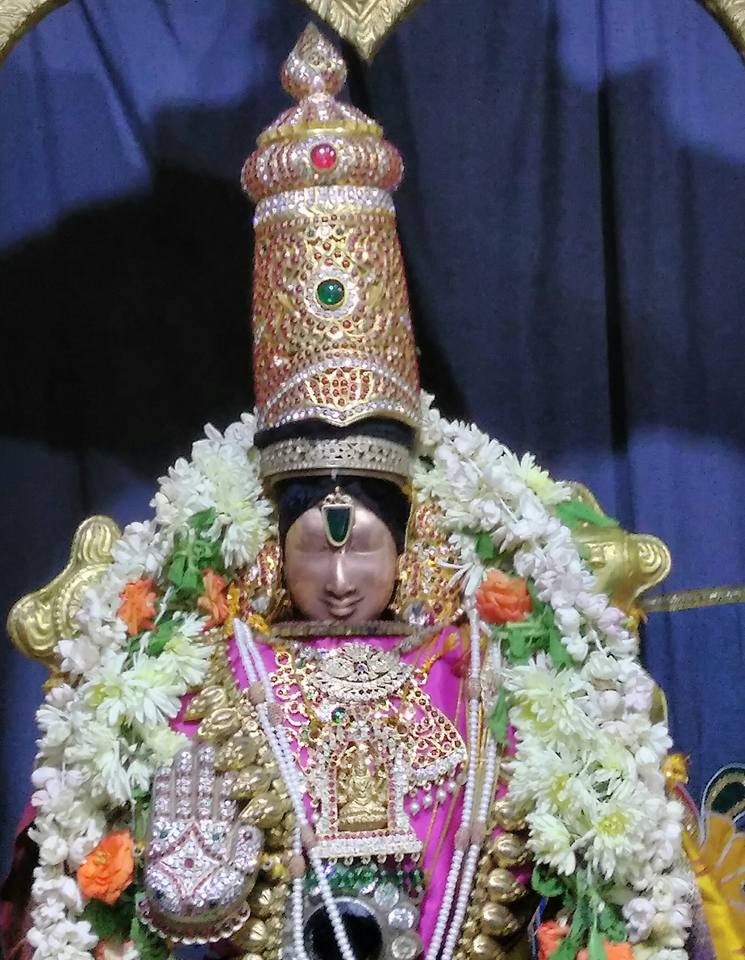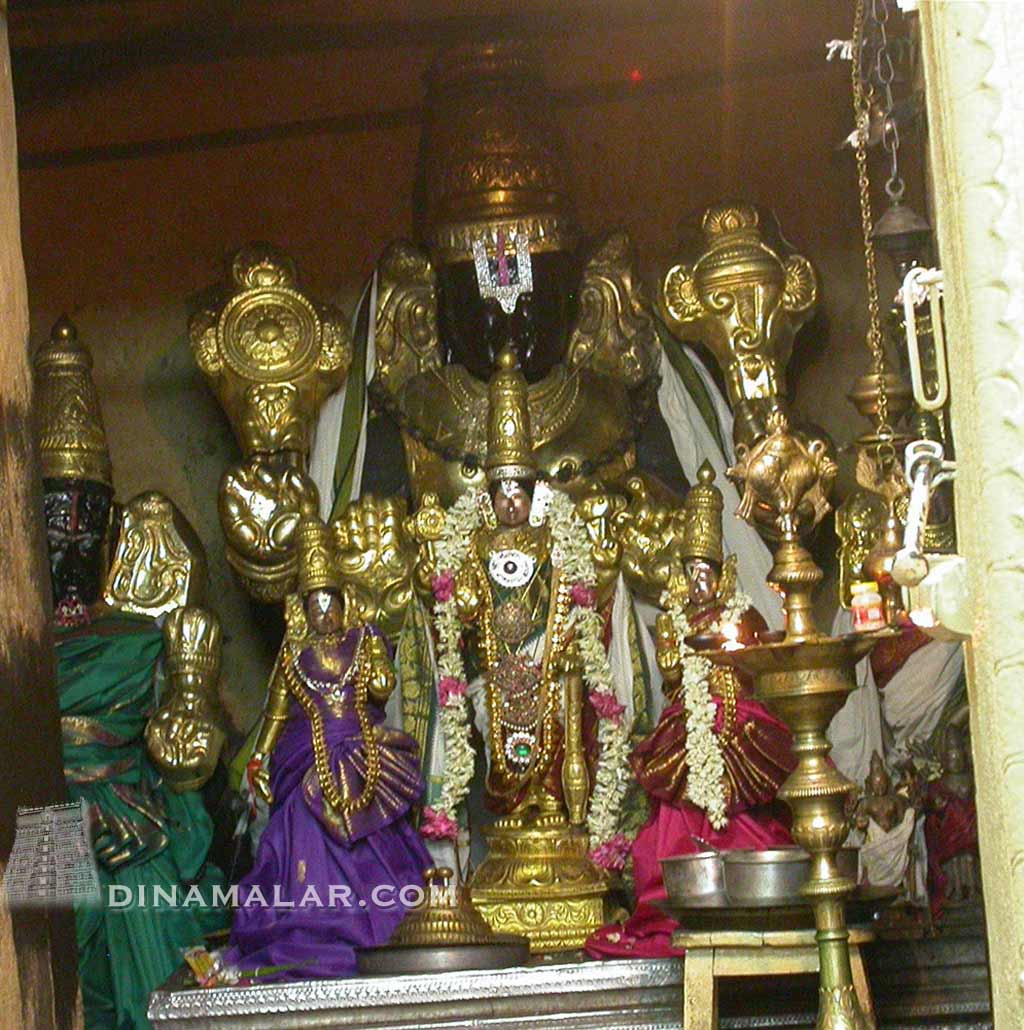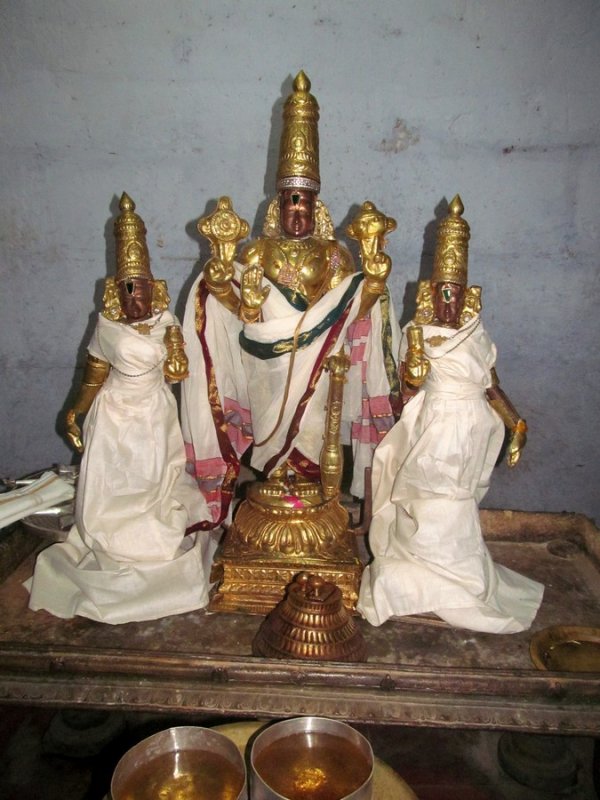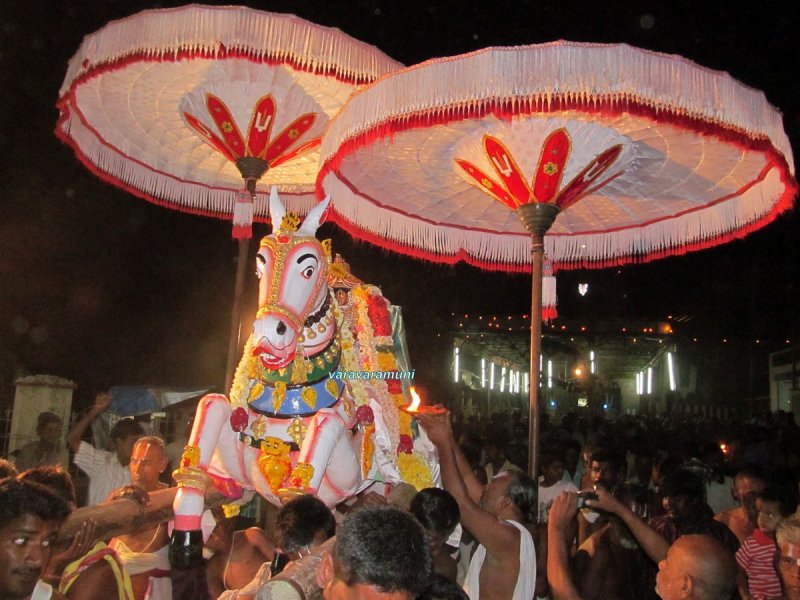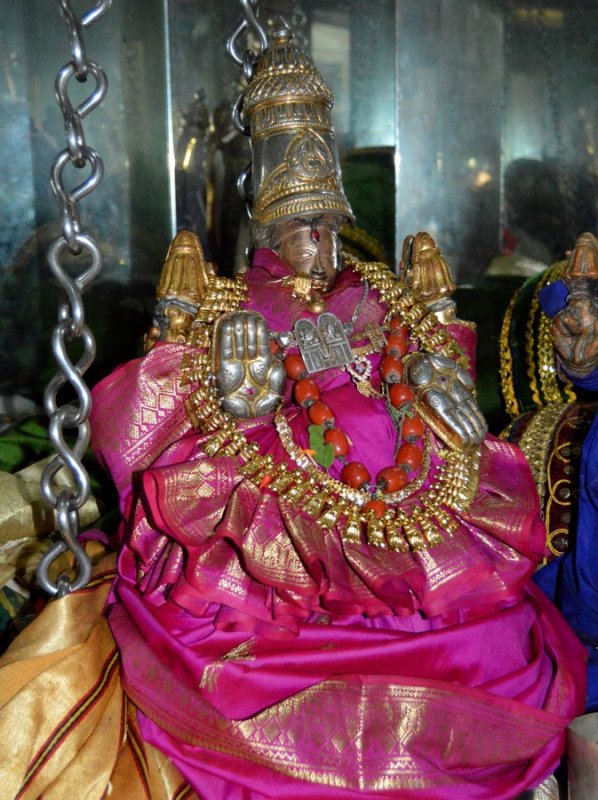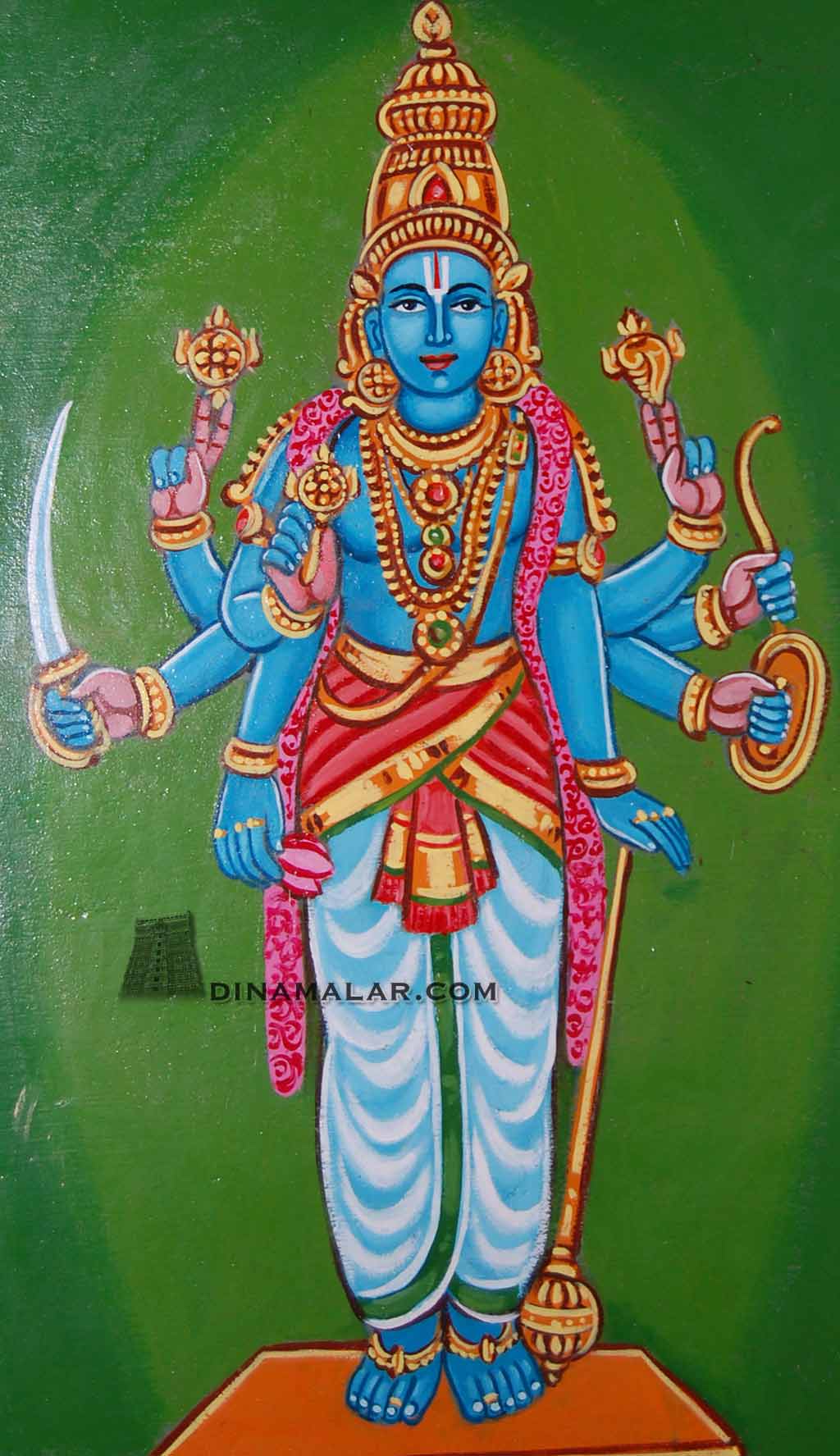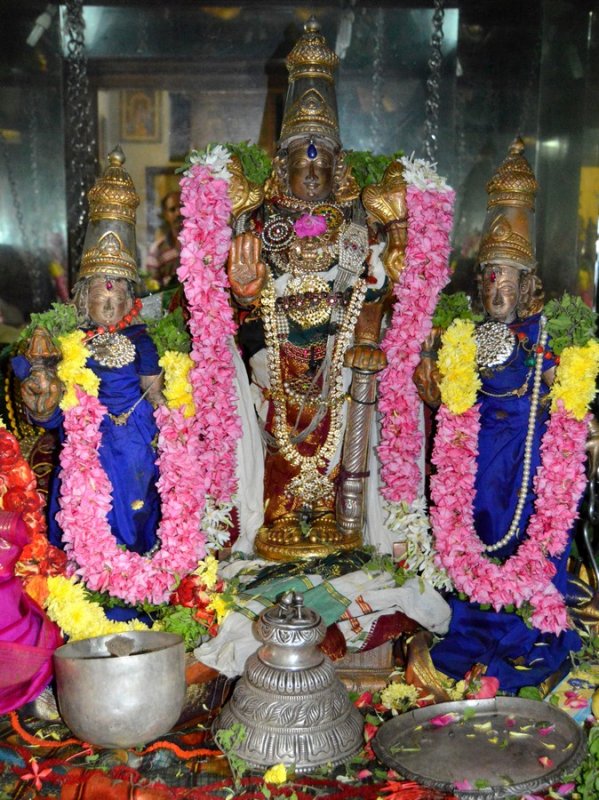GITA 11.40
At present we are in Tiruputkuzhi in Thondai Nadu [தொண்டை நாடு]. The Lord here is called Sri Poretru Nayanar, Sri Vijayaraghavan and Sri Samarapungava. Around the prakaram [corridor] Acharyas all are gracing. We can see Swami Ramanuja's sannidhi. Swami Ramanuja is closely associated with this Kshetram. Next we see the sannidhi of Vishadavak Sikhamani Swami Manavala Mamunigal. It is said that he came here and was greatly absorbed by the beauty of the Lord. Next, is Swami Vedanta Desika's sannidhi. Swami Desika published Paramarta stuti stotram and explained that here we see the proof of and truth of the grant of Moksham to a vulture King. Today's [20th November 2008] lecture is from Sri Thayar's sannidhi.
Sri Thayar here is Sri Maragathavalli Nacchiyar [ஸ்ரீ மரகதவல்லி நாச்சியார்]. No one worships by simply saying this name, but by saying varuttha payiru mulaikkum Sri Maragadhavalli Nacchiyar [வறுத்த பயிறு முளைக்கும் ஸ்ரீ மரகதவல்லி நாச்சியார்]. Why this special title for Sri Thayar here? Those who do not have children, come here and bathe in Gruddhara pushkarini. They, then tie on their body, some fried payiru [pulses], and worship and stay in the place overnight. Next morning they discover germination of the pulse seeds and are blessed with children. Such is Her greatness. Sri Thayar as Sri Santhana Lakshmi and Sri Maragadhavalli Thayar graces. We should regard Her as Sri Sita, as the Lord is Sri Vijayaraghava. It is a pleasant coincidence that the recording of the lecture was done on a Friday. Her hand showing Abhaya, suggests that She assures us that She would make the Lord agree to bless our needs and ensure grant all pleasant things including Moksham. Her left hand is pointing to Her Divine feet. It is customary to first worship Her, before worshipping the Lord. When Sri Rama granted Moksham to Jatayu, Sri Thayar was not nearby; but to offset that shortcoming, here Sri Thayar is along with the Lord. About this Kshetram, Swami Pillai Perumal Iyengar has composed a pasuram in his '108 Tirupati andhadi [நூற்றெட்டு திருப்பதி அந்தாதி]'. He imagined the pit as a pit of fire. When Prahlada refused to utter names other than Sri Narayana, Hiranyakasipu tortured him by pushing down a hill, made him to drink poison, tried to tramp on him by an elephant, made snakes to bite him, immersed him in the ocean, etc. Finally, he drowned Prahalada in a pit of burning fire. But Prahlada was not harmed by the fire. He was chanting the Lord's name and, after all, the fire got its power from the Lord only.
In the last sloka, we saw Arjuna mentioning the Lord as Agni, god of fire. Thus Prahalada was unaffected by the fire. Swami Pillai Perumal Iyengar compares neruppukuzhi [a pit of fire நெருப்புக் குழி] and Tirupputkuzhi. Vimanam of this temple is called Vijaya Veera Koti vimanam [விஜய வீர கோடி விமானம்].
Vimanam publicizes to the World that below it is the Lord of Victory [Vijaya] and Valour [Veeram]. By prostrating unto Him, one can obtain Moksham. Now we will proceed to sloka 41. Arjuna now prays the Lord to pardon him for his faults. Sloka 41:
 |
| UTSAVAR SRI MARAGATHAVALLI THAYAR |
Sri Thayar here is Sri Maragathavalli Nacchiyar [ஸ்ரீ மரகதவல்லி நாச்சியார்]. No one worships by simply saying this name, but by saying varuttha payiru mulaikkum Sri Maragadhavalli Nacchiyar [வறுத்த பயிறு முளைக்கும் ஸ்ரீ மரகதவல்லி நாச்சியார்]. Why this special title for Sri Thayar here? Those who do not have children, come here and bathe in Gruddhara pushkarini. They, then tie on their body, some fried payiru [pulses], and worship and stay in the place overnight. Next morning they discover germination of the pulse seeds and are blessed with children. Such is Her greatness. Sri Thayar as Sri Santhana Lakshmi and Sri Maragadhavalli Thayar graces. We should regard Her as Sri Sita, as the Lord is Sri Vijayaraghava. It is a pleasant coincidence that the recording of the lecture was done on a Friday. Her hand showing Abhaya, suggests that She assures us that She would make the Lord agree to bless our needs and ensure grant all pleasant things including Moksham. Her left hand is pointing to Her Divine feet. It is customary to first worship Her, before worshipping the Lord. When Sri Rama granted Moksham to Jatayu, Sri Thayar was not nearby; but to offset that shortcoming, here Sri Thayar is along with the Lord. About this Kshetram, Swami Pillai Perumal Iyengar has composed a pasuram in his '108 Tirupati andhadi [நூற்றெட்டு திருப்பதி அந்தாதி]'. He imagined the pit as a pit of fire. When Prahlada refused to utter names other than Sri Narayana, Hiranyakasipu tortured him by pushing down a hill, made him to drink poison, tried to tramp on him by an elephant, made snakes to bite him, immersed him in the ocean, etc. Finally, he drowned Prahalada in a pit of burning fire. But Prahlada was not harmed by the fire. He was chanting the Lord's name and, after all, the fire got its power from the Lord only.
In the last sloka, we saw Arjuna mentioning the Lord as Agni, god of fire. Thus Prahalada was unaffected by the fire. Swami Pillai Perumal Iyengar compares neruppukuzhi [a pit of fire நெருப்புக் குழி] and Tirupputkuzhi. Vimanam of this temple is called Vijaya Veera Koti vimanam [விஜய வீர கோடி விமானம்].
 |
| VIJAYA VEERA KOTI VIMANAM |
Vimanam publicizes to the World that below it is the Lord of Victory [Vijaya] and Valour [Veeram]. By prostrating unto Him, one can obtain Moksham. Now we will proceed to sloka 41. Arjuna now prays the Lord to pardon him for his faults. Sloka 41:
sakheti matva prasabham yad uktam
he krishna he yadava he sakheti
ajanata mahimanam tavedam
maya pramadat pranayena vapi
"Thinking of You as my friend, I have rashly addressed You “O Krishna,” “O Yadava,” “O my friend,” not knowing Your glories. Please forgive whatever I may have done in madness or in love."
Normally, this sloka and the next [42nd sloka] are to be read together. But since there are deep meanings, at present we will see this sloka today. Sakha = friend [of Arjuna], matva = thinking. Before Arjuna saw the Viswaroopam, he thought of Sri Krishna merely as his Friend of him or a close Cousin of him. Prasabham = indecently or disrespectfully, yad uktam = whatever was uttered [by Arjuna], he krishna = hey! Krishna, he yadava = hey! Yadava, he sakheti = hey! [my] Friend. Arjuna might have called the Lord by His First name or by His profession of cowherding. Though Sri Krishna was still Arjuna's Friend, he had realized the greatness of his Friend after seeing the Viswaroopam. Ajanata = out of ignorance, tava = Your [Sri Krishna's], idam = this, mahatmanam = great glory [of the Lord in Viswaroopam showing that everything was His property and everyone was in His command], maya = by me [Arjuna], pramadat = casually, pranayenava = or out of love. Arjuna prays to the Lord that he might have addressed Sri Krishna, without dignity, as Krishna or Yadava or My friend, etc. Krishna actually is a very noble word. Krishna means showering happiness on the earth. But Arjuna might have called the Lord as Sri Krishna meaning the Black! Yadava denotes the Gem of Yadava dynasty. But Arjuna addressed the Lord as Yadava meaning cowherd! He addressed the Lord as Friend, with the ego that he was from Kshatriya community and Sri Krishna, after all, was from cowherds. All these he told out of ignorance of the greatness of the Lord. He addressed by all these out of carelessness or out of affection. We may remember these words, and see how they coincide with the words used by Sri Andal [in Tiruppavai - karavaigal pin senru கறவைகள் பின் சென்று... ]. She says that She addressed the Lord by insignificant names [siru per சிறு பேர் ]. So He should not mind and get angry [ seeri சீறி]. She says that starting from the First pasuram [ margazhi thingal மார்கழித் திங்கள்..], She had addressed the Lord by casual names, but She realized later and so made amends to this indifference. Why did She address like that? Because She and Her friends were ignorant [ariyada அறியாத ]; out of childishness [pillaigal பிள்ளைகள்]; out of love [anbinal அன்பினால்]. These three words are used by Arjuna as ajanat, pramadat and pranayenava. But there is a difference in Arjuna and Sri Andal telling. She addressed the Lord as Narayana [1st pasuram], parkadalul paraman [பாற்கடலுள் பரமன் 2nd pasuram], ulagalanda utthaman [உலகளந்த உத்தமன் 3rd pasuram], oozhi mudalvan padmanabhan [ஊழி முதல்வன் பத்மநாபன் 4th pasuram] and mayan [மாயன் 5th pasuram]. According to Her, all these were insignificant names! In reality, those were all very sacred and great names. But in pasurams 27 [koodarai vellum கூடாரை வெல்லும்], 28 [karavaigal pin senru கறவைகள் பின் சென்று] and 29 [ chitranchirukalai சிற்றஞ்சிறு காலை], She mentions the name, Govinda. According to Her, again, this is a great name of the Lord! Till these pasurams She did not know the True Self of the Lord and so addressed Him by insignificant or casual names; but after truth dawned in Her, She addressed Him by great names. Govinda means going behind cattle. While Narayana means the Prime Cause of Universe. Which is a greater name? Actually, Narayana is the greater name. But Sri Andal tells the other way. Because, after all, the Lord took Avatar in Gokulam, to hide His greatness. So, He never liked people to remind Him of His greatness. In this Avatar, Sri Krishna wanted people to address Him as Krishna, Yadava, Navanita Chora, etc. This is the opinion of Sri Andal and so She sang like that. And, for that, She seeks His pardon. While Arjuna is doing the opposite. He, before seeing the Viswaroopam, addressed the Lord casually and with insignificant names. Now, he addresses the Lord as Narayana, Padmanabha, Trivikrama, etc. Sri Andal was in Bhakti marg and so She wanted to address the Lord in Her way; while Arjuna in Gyana marg, wants to address the Lord in his way.
(continued)
